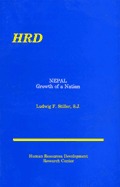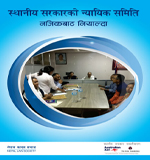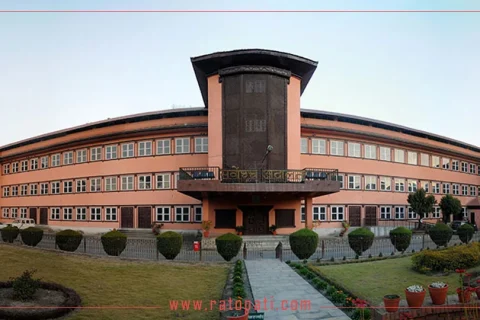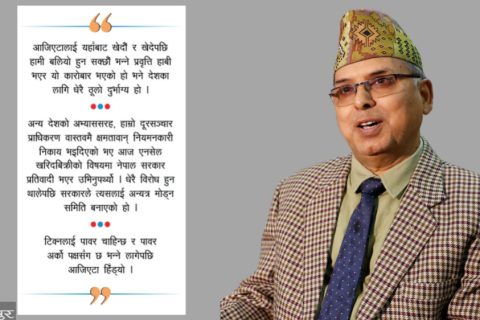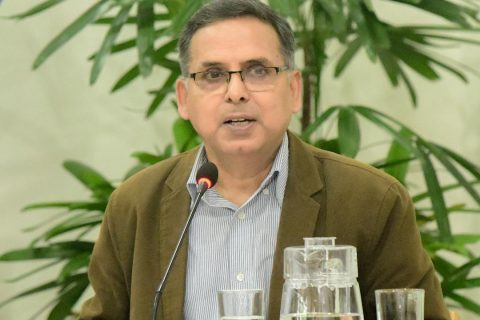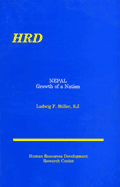
Ludwig F. Stiller, S. J., Nepal: Growth of a Nation (Kathmandu: Human Resources Development Center, 1993)
Ludwig F. Stiller, S. J. is not a new name in Nepal. He was a famous American Nepalese historian who produced a couple of distinguished books on Nepal’s history. The theme of the present work, Nepal: Growth of a Nation, published in 1993, is broad and challenging. It talks about the land and people of Nepal, the vision of the country and its leadership, the politics for profit, control and centralization, and the new awakening. The author covers these themes through the last two hundred years of Nepalese history.
In the opening paragraph of the book, the author states that “the Nepalese nation was born against improbable odds. In the most difficult terrain imaginable, the Nepalese achieved unity and then withstood the British threat to rule South Asia. Today, landlocked and hedged in by great powers, the Nepalese still proudly assert their independence in the family of nations. At home, their chief concern is development. Internationally, though Nepalese troops are everywhere respected, the Nepalese stand for nonalignment and peace. In fact, few have attained the peace the Nepalese enjoy.” Here, the author is speaking his mind about the country as it was in 1993.
The book has fourteen small chapters. Chapter I deals with the land of Nepal and its people. It is based mainly on chapters 1, 2 and 3 of the author’s 1973 book, entitled The Rise of the House of Gorkha. Chapter II deals with the Founder of modern Nepal, King Prithvi Narayan Shah, who unified the smaller principalities in Nepal to form a strong country. The unifier, Stiller mentions, “respected and worked with the regional, cultural, social and fiscal administrations he found, no matter how disparate they seemed.” Forty years later, after the unifier’s death in 1775, Stiller points out, Nepal suffered its greatest single military set back at Almora in Kumaon in Anglo-Nepal War (1814-16). This is the background with which Chapter III deals with the spoils of the war.
Chapter IV is a narrative of the country’s painful growth. When King Rana Bahadur dismissed Bahadur Shah, the regent of Nepal from 1785 to 1794, and began to rule the country directly, he was only nineteen years of age. As the court was deeply divided by factions, the situation demanded an experienced leader to govern the country. However, King Rana Bahadur was still young and inexperienced. The reforms Bahadur Shah, his uncle, proposed in 1793 suggested that he had finally come to grips with the financial problems that the newly-unified country faced, but those reforms were never implemented. Here, Stiller notes that “nothing more was heard of them once the new king took control of the state.”
Chapter V is about the Anglo-Nepal War, as noted above, and its handling by Prime Minister Bhimsen Thapa. Unlike the other great leaders in Nepal, Stiller states Bhimsen Thapa was “neither a man of vision nor gifted with a sense of history.” Chapter VI analyzes postwar stagnation in the country while Chapter VII explains the power politics in the new context. Stiller makes it clear at this point that by ordering the death of Prime Minister Mathbar Singh Thapa, Rajendra Bikram Shah, the King at the time, “destroyed the last vestige of trust the people placed in him.”
Chapter VIII is the account of the Mutiny and the rise of Jung Bahadur – the founder of Ranarchy or the system of hereditary prime ministers in Nepal. The next chapter covers Jung Bahadur’s last few years. Despite Jung’s autocratic rule, Stiller makes a point that “his reforms did indeed strengthen the nation.” Chapter X deals with Ranoddip and Bir Shamsher, the next Rana rulers. Chapter XI and XII are about Prime Minister Chandra Shamsher, who in Stiller’s opinion, greatly stabilized Nepal during his time. Similarly, despite several problems, Chandra bequeathed to succeeding Prime Ministers a growing Nepalese nationalist movement. Chapter XIII covers the subsequent political awakening in the country. Building on this, Chapter XIV, entitled “In the End is the Beginning,” deals with the author’s last few remarks.
Written in a very lucid manner, Stiller’s book highlights Nepal’s growth after its unification by King Prithvi Narayan Shah until the dawn of democracy in 1950-51. Many of his themes, as listed in the beginning, build on what the author has already worked on: The Silent Cry: the People of Nepal 1816-1839 (1976), Planning for People: A Study of Nepal’s Planning Experience (1979) (co-authored with Ram Prakash Yadav), Letters from Kathmandu: the Kot Massacre (1981) and The Rise of the House of Gorkha (1995).
In the context of what happened in 1950-51, the year of revolution, some of the analysis in the book is very illuminating. The effort to explain how Jawahar Lal Nehru, India’s Prime Minister at the time, was able to manipulate Nepal’s situation to India’s advantage makes Chapter XIV interesting to any reader.
The posthumous 2001 publication of the ‘Atmabritanta’ of Late B. P. Koirala, the leader of 1950-51 revolution, has already given history students the perspective of manipulation straight through the horse’s mouth. It is so enlightening that Stiller was able to explain this situation with such accuracy so many years ago. At the climax of movement, Nepali Congress planned for the abduction of King Tribhuvan, who would be taken from Kathmandu to Western Nepal, presumably Palpa. They thought of establishing a constitutional government under the King from Palpa itself. There was a plan to revolt against the Rana government by sections of the Nepal army. The abduction of King Tribhuvan was to take place in September, during the week-long Indra Jatra festival, and the revolt in the army was to be sparked by several ‘C’ class Ranas and Shah family officers. The Indians in Kathmandu were clever enough to outbid the Congress and write a new course for the revolution.
As Stiller has clarified, “after King Tribhuvan and his family left Kathmandu on November 10, 1950, the battle for control of Nepal began in earnest. That very afternoon, a Nepali Congress plane airdropped leaflets over Kathmandu to announce the Congress revolution and appeal for popular support. The following day, the Congress liberation army raided Birganj and ‘liberated’ government offices there. On November 12th, the Congress airdropped leaflets over other major town in Nepal. Nehru put an end to this. On November 15th, before the Congress could carry out a major attack, the Uttar Pradesh government in India banned the use of Indian railways for paramilitary action against Nepal. The following day, air flights from Indian territory over Nepal were banned. King Tribhuvan was Nehru’s guest, and Nehru intended to use his presence in Delhi to force the Prime Minister, and if necessary the Nepali Congress, to negotiate a peaceful settlement.”
As the story goes, “Nehru’s proposal was the Delhi compromise. Despite the Government of India’s restrictions on their activities, the Nepali Congress liberation army launched successful attacks in both East and West Nepal. By the time the Congress had these victories to report, Mohun Shamsher had already accepted the Delhi compromise. The Congress case was further weakened by the fact that there had been no mass uprising in support of the congress revolution. Although the Delhi compromise denied the Congress the total victory Congress leaders felt necessary to bring about real change in Nepal, they were obliged to accept the Delhi compromise or be left completely out of the final solution.”
Stiller reminds, “In the meanwhile, Nehru used to India’s advantage Mohun’s assurance that Nepal would stand by the new government of India as it had the old. On July 1, 1948, Nehru asked him officially for the services of ten battalions of the Nepal army for garrison duty in India. The Indian Ambassador explained that this would free the Indian army for duty in Kashmir (and in Hyderabad, as it later turned out). When Mohun discussed Nehru’s request with the British ambassador, the Ambassador warned him that compliance with this request might impede Nepal’s application for membership in the United Nations. … Reluctantly, Mohan signed the agreement on July 18th. BY August 5th the troops were their way to India, where they served from August 1948 until April 1949. During that time, India settled both the Kashmir and Hyderabad issues to its own satisfaction. In 1949, Nepal’s application for admission to the U.N. was vetoed. Not until 1955 did Nepal sign admission to this world body.”
The story goes on: “Nehru continued to press the Nepalese Prime Minister. The Nepal India ‘standstill agreement of 1947 had implied that Nepal and India would eventually sign a treaty defining their relationship more accurately. When Mohun visited Delhi in February, 1950, he learned that Nehru had prepared just such a treaty. In their discussions, Mohun and Nehru covered the whole range of Nepal-India relations. When Mohun returned to Kathmandu, he carried the text of two treaties: one, a Treaty of Peace and Friendship, the other, a Treaty of Trade and Commerce. Along with the treaties, Mohun had carried Nehru’s firm reminder that he would have to introduce political reforms.” The Treaty of Trade and Commerce was calculated to “prevent Nepal from developing into a little Hong Kong, serving as an entrepot between the international market and India.” As far as the second treaty was concerned, the secret letters of exchange accompanying the treaty contained a modern version of the traditional clause, “your enemies will be our enemies, and our enemies will be your enemies.” “The Nepalese had shied away from their principle in all their dealings with the British, and the whole weight of Nepalese history was against accepting it now.” Mohun had set out to prove to Nehru that friendly relations between Nepal and India required no political change in Nepal. With this treaty, Nehru was clearly asking to prove it. “Almost unchanged, the treaties were signed in Kathmandu on July 31, 1950.”
In his Epilogue, Stiller notes that the end of the Rana rule in 1950 was incidental in a way. “The real challenge to the Nepalese people was the democratic era.” On this, Stiller explains that the post 1950 political developments have been frustrating for the growth of the nation. “King Mahendra indicated his intense dissatisfaction with the direction the political debate had taken by his intervention of December, 1969. In his constitution of 1962, King Mahendra introduced Panchayat democracy in a serious effort to strengthen the voice of the people. Three major amendments to that constitution underlined the difficulty of opening the political debate to the people in a country with such poor communications.” The state bureaucracy during the Panchayat system, notes Stiller, was also reluctance to yield power to the people. The good thing, however, was “the large turnover of elected officials in later Panchayat elections suggest[ing] that the people had begun to take their future into their own hands.”
Stiller further adds: “The popular movement of 1989 that led to a complete change of government and the restoration of parliamentary democracy was a clear sign that the will of the people was not heeded by those then in power. Whether or not the government swept into power by that popular movement will function according to the will of the people remains to be seen. It seems certain, however, that the people, under the guidance of their King, will prevail over the hesitancy of the elite to accept the constraints of a democratic system.”
Reading again, after 18 years of its publication, the book Nepal: Growth of a Nation is still a concise but a very thoughtful analysis of Nepal’s experience with its nation-building challenges. Stiller has both the heart and mind to explain the vicissitudes Nepal had to face over the two hundred years of its unstable history. No doubt, the book is a great piece of work.

